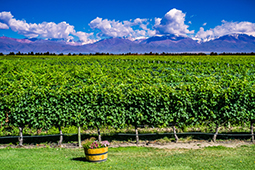With the winter months in full swing, consumers are naturally looking for wines to pair with their hearty seasonal meals. Wines from the high-altitude region of Argentina-South America's largest and fastest-growing wine region-bring the warmth of their home country to your customer's table.
Here are four things you need to know to help make your Argentinian wines as enticing, and sellable, as possible.
Ain't no mountain high enough
Argentina's wine growing regions are unique for the high altitude that they are produced in. That factor, along with low humidity, means that Argentinian wines rarely face issues that affect vineyards in other countries.
 "The fact that Argentina is at such a high altitude, winemakers do not have to worry about a lot of insects, bacteria and other things that will mess with the wines, which creates longevity in the vineyards," said Sam Heider, Breakthru Beverage Colorado Fine Wine Development Manager. "Argentina has some of the oldest vines growing in the world. We're talking upwards of 150 year-old vines that are still producing fruit."
"The fact that Argentina is at such a high altitude, winemakers do not have to worry about a lot of insects, bacteria and other things that will mess with the wines, which creates longevity in the vineyards," said Sam Heider, Breakthru Beverage Colorado Fine Wine Development Manager. "Argentina has some of the oldest vines growing in the world. We're talking upwards of 150 year-old vines that are still producing fruit."
This allows cultivating with little or no pesticides, enabling clean and even organic wines to be easily produced.
Ultra-premium price tier is on the rise
When Argentinian wine first made waves in the U.S., led by chief import Malbec, they were known for the exceptional value they offered with a low price point. As familiarity and demand have risen for Malbec, and Argentinian wines overall, so have the prices that consumers are willing to pay. Having a variety of options besides the traditional $9.99 Malbec can drive greater revenue and profit. Recent figures from Nielsen show the ultra-premium price tier ($15-19.99) is up 3.2%.
More than Malbec
The predominant grape from Argentina is Malbec, a Bordeaux variety imported to Argentina from France in the mid 19th century. Other red varieties produced in Argentina include Cabernet Sauvignon, Merlot, Bonarda, Syrah, Tempranillo and Pinot Noir. While Malbec's predominance may lead some consumers to think red when they think Argentina, Torrontés, a floral, tropical-tasting white grape indigenous to Argentina has also established itself as a noteworthy addition to any wine list or shelf. The country also produces Chardonnay, Sauvignon Blanc and Pinot Grigio.
Pair it well
The rich flavor and diversity found in Argentinian wines make them ideal for food pairing. The traditional marriage of Malbec and meats are well suited for menus featuring sirloin, poultry, pasta or hard cheeses. However, its versatile terroir also pairs well with chocolates and other desserts. Torrontés is also exceptionally pairable, as it coexists in harmony with intense and hot flavors, working very well with Japanese, Chinese or Thai cuisine. With the spring season (hopefully) not far away, Torrontés is also a great wine for the patio.